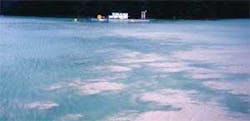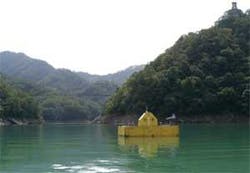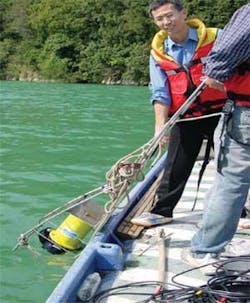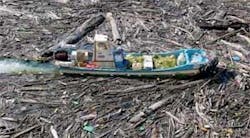Monitoring Reservoir Water Quality in Taiwan Tames Turbidity after Typhoon
Unattended water quality monitoring equipment from YSI helps protect drinking water supply at Taiwan’s Shimen Reservoir by allowing treatment system operators avoid shutdowns due to turbidity spikes from erosion after typhoons.
null
By Danielle Dumont
The steep 500m (1,600 ft) peaks and dramatic canyons that make the Shimen Reservoir one of Taiwan’s popular tourist attractions are the products of massive erosion – erosion that threatens the reservoir’s role as a key supply of domestic water.
The problem came to a dramatic head in August 2004, when Typhoon Aili unleashed 20 million metric tons of sediment and debris into the reservoir from the surrounding mountains. Turbidity climbed from the usual 40 NTU to spike at 70,000–120,000 NTU. The sediment choked the reservoir’s water treatment plant, which was equipped to handle water with no more than 3,000 NTU. Tap water was cut off for days to thousands of households, and residents were forced to rely on water trucked in by the Taiwan Water Supply Corp.
The 2004 typhoon was big. At 973 mm (38 inches) of rain, it represented half of a typical year’s precipitation – but it wasn’t unusual. The area around Shimen Reservoir is typically hit by two to four typhoons a year, and suspended solids discharged by landslides around the reservoir present a constant challenge to the Ministry of Economic Affairs’ Water Resources Agency’s Northern Region. Adding to this, the sediments often travel in subsurface plumes across the 800–hectare (1,977–acre) reservoir, presenting a hidden hazard that can quickly overwhelm the dam’s water treatment facility.
null
Vertical Profiling
Before the 2005 typhoon season, the Water Resources Agency deployed YSI Vertical Profiling Systems mounted to pontoons at two points in the reservoir. Each profiling system uses a YSI multiparameter sonde to conduct autonomous vertical profiles of the water column as the water approaches the Shimen Dam. The YSI 6600EDS sondes report back to the dam’s operations office every three hours, logging turbidity, chlorophyll, pH and dissolved oxygen (DO) readings every five meters from surface to bottom. When turbidity reaches critical levels, the profilers’ data trigger an emergency plan at the water treatment plant, according to Bergius Su of Taipei–based Smartec, which provided and services the equipment. A team of technicians promptly begins a program of manual sampling to confirm the problem and determine its extent. Finding the size, shape and depth of the plume allows water treatment plant managers to choose among several management options:
- Accelerating fill–up of the storage pond immediately above the water treatment plant;
- Closing any of the plant’s five water intakes and opening others to draw in water from clearer levels in the water column and avoid the turbidity plume;
- Drawing water into the plant from a backup source in a nearby river.
Careful Positioning
Smartec used a SonTek/YSI ADP (Acoustic Doppler Profiler) to identify optimal deployment locations with minimal current for the Vertical Profiling Systems. The system closest to the dam is anchored in 50m (164 ft) of water; the more distant sampling site is 40m (131 ft) deep. Forty–kilogram (88–lb) anchors hold the pontoons in place.
Those anchored floats have weathered several typhoons, though vertical profiling is sharply curtailed in rough weather, notes Keith Leung of YSI’s office in Hong Kong. When storms hit, Smartec remotely locks the sondes in position immediately beneath the floating platform. At the dam management’s request, Su and his team can activate the sondes remotely or manually to sample at 10m intervals, or the Smartec crew can begin conducting manual readings with YSI 6600EDS sondes and grab–sampling equipment.
Smartec also conducts monthly calibrations and maintenance of the equipment. Leung notes that the self–wiping feature of the sondes reduces buildup of biofouling, and points out that calibration is a quick process. He adds that the Water Resources Agency staff was already quite familiar with maintenance of YSI equipment because of its years of experience with the 6600EDS sondes, so the dam’s staff is quite comfortable with handling the profilers.
Data Flow
The sondes make their journey from the reservoir’s surface to the bottom and back every two hours, and report values via Wi–Fi for all parameters back to the dam office – about 5km (3 miles) away – every three hours. Their data are integrated with information gathered at eight grab–sample stations. Information is primarily used for managing the dam and water treatment plant; but the Water Resources Agency also has contracted with a professor from Taiwan University to develop a data–gathering and analysis protocol and a water quality model. Ultimately, predicts Su, data from the continuous vertical profilers could be integrated into the Shimen Runoff Forecast Model or the dam’s flood control operations.
The chlorophyll and DO sensors on the sondes could someday be used to track the movement of algae in the reservoir, adds Leung, protecting the lake’s carp fishery and helping managers prevent anoxic events.
For now, the mission to track suspended sediment is important enough, Leung says: “Every year, landslides triggered by typhoons represent a significant threat to the water treatment plant at the Shimen Reservoir. Using long–term, unattended monitoring technology throughout the water column protects the plant from unseen sediment. Doing that, it protects the people who count on water from the reservoir for their household needs. The project at Shimen is an outstanding use of this equipment, going beyond pure science into public service.”
Author’s Note:
Danielle Dumont is corporate communications manager for YSI Inc., with headquarters in Yellow Springs, Ohio, USA. YSI units participating in this project include YSI Integrated Systems & Services, based in Marion, Massachusetts, USA, and YSI Ltd., based in Hong Kong. Contact: +852 2891 8154, [email protected] or www.ysi.com
Taiwan’s Shimen Reservoir
When completed in 1953, Taiwan’s Shimen Dam was the largest in Southeast Asia. At 133m (436 ft) high and 330m (1,082 ft) wide, the dam holds back 218 million cubic meters of water. Its impressive scale and breathtaking scenery make it a favorite stop for tourists in the region.
Some sediment travels into the lake with the flow of the Da–Han River, but the biggest threat from suspended solids comes from landslides in the steep mountains surrounding the reservoir triggered by annual monsoons.
The Shimen Dam’s water treatment plant can handle water of as much as 3,000 NTU, but plumes of turbid water with many times that concentration of sediment can clog the works in minutes. The plant has five separate intakes from the reservoir. Unattended monitoring of the water column helps ensure intakes are opened and closed to draw clean water and avoid turbid supplies after typhoons, preventing costly damage and interruptions in the region’s water supply.





